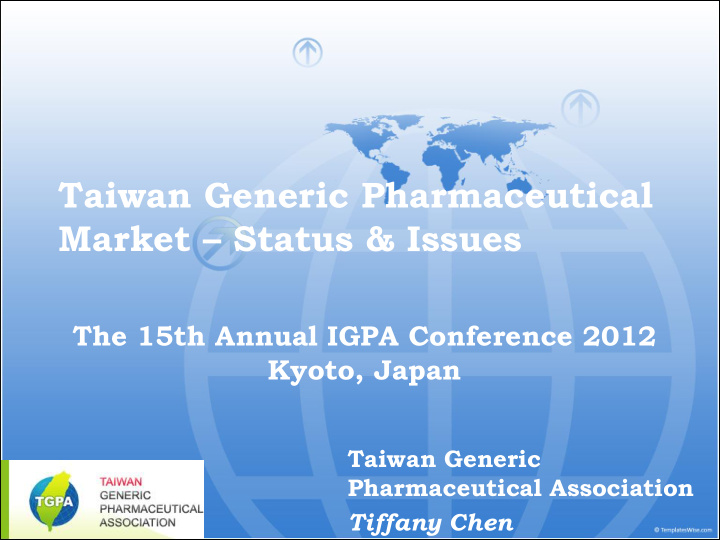



Taiwan Generic Pharmaceutical Market – Status & Issues The 15th Annual IGPA Conference 2012 Kyoto, Japan Taiwan Generic Pharmaceutical Association Tiffany Chen
OUTLINE • Taiwan Pharmaceutical Market Overview • Major Issues • Possible Solutions
Geography • Population: 23 million • Healthcare providers: HP: 477 GP: 9,956 DS: 5,199 (contracted) Generic definition follows IMS Taiwan definition, Which consider all local manufactures are generics and foreign manufactures are branded due to Taiwan IMSPlus data limitation
Taiwan Pharmaceutical Market Overview – 1/20 US$ 4,598 million Exchange Rate : 29.5 (NT$/1 US$)
Taiwan Pharmaceutical Market Overview – 2/20 US$ 4,598 million
Taiwan Pharmaceutical Market Overview – 3/20 US$ 4,598 million
Taiwan Pharmaceutical Market Overview – 4/20 US$ 4,598 million Foreign companies: 30 Local companies: 160
Taiwan Pharmaceutical Market Overview – 5/20 Medical center: 22 US$ 4,598 million Regional hospital: 83 Area hospital: 372 Total: 477
Taiwan Pharmaceutical Market Overview – 6/20 US$ 4,598 million Total: 5,199 (Contracted)
Taiwan Pharmaceutical Market Overview – 7/20 US$ 4,598 million Total : 9,956
Taiwan Pharmaceutical Market Overview – 8/20 US$ 4,598 million
Taiwan Pharmaceutical Market Overview – 9/20 US$ 4,598 million
Taiwan Pharmaceutical Market Overview – 10/20 US$ 4,598 million
Taiwan Pharmaceutical Market Overview – 11/20 US$ 4,598 million
Taiwan Pharmaceutical Market Overview – 12/20 US$ 4,598 million
Taiwan Pharmaceutical Market Overview – 13/20 US$ 4,598 million
Taiwan Pharmaceutical Market Overview – 14/20 US$ 4,598 million
Taiwan Pharmaceutical Market Overview – 15/20 US$ 4,598 million
Taiwan Pharmaceutical Market Overview – 16/20 US$ 4,598 million
Taiwan Pharmaceutical Market Overview – 17/20 US$ 4,598 million
Taiwan Pharmaceutical Market Overview – 18/20 US$ 4,598 million
Taiwan Pharmaceutical Market Overview – 19/20 US$ 4,598 million
Taiwan Pharmaceutical Market Overview – 20/20
Major Issues • Branded products still dominate Taiwan market (77% versus 23%) • N ational H ealth I nsurance policy still plays the key role as well as the coming 2 nd generation NHI • Relatively lower medical expenditure versus other countries • Reimbursement price cut led by price-volume survey (PVS) every two years • Bureau of Health Insurance presents the continuing financial deficit
Lower Medical Expenditure USA USA Holland Switzerland France Norway Switzerland Holland Germany Canada Canada Austria Austria Germany Belgium France New Zealand Belgium Sweden Sweden Medical Average medical England Australia expenditure/GDP expenditure/ Spain England person/year Japan Finland Norway Spain Italy Japan Australia New Zealand Finland Italy Czech Taiwan S. Korea S. Korea Czech Taiwan Mexico Mexico
Major Issues • Products losing patent protection will have their prices reduced to a “ reasonable ” level within five years, under Article 46 of the 2G NHI Act, due to be implemented at the start of 2013. As a result, there will be deeper cuts to prices earlier than before which will lower the motivation to multinational companies launching new products in Taiwan • Foreign generics take the advantage of higher reimbursement price compare to local generics
Major Issues • The BNHI is now starting its review process as soon as the T aiwan F ood and D rug A dministration issues an approval letter, which should save three or more months from the time taken for reimbursement listing and pricing. However, the drug lag in Taiwan will get even longer if China starts to benchmark low Taiwanese prices , since companies will want to be approved first in the larger market before launching in Taiwan
Possible Solution • Generic penetration will accelerate, helped by higher prices – up to 100% of the original product price - for generics that meet tougher quality standards, as manufacturers will be able to answer quality concerns and offer larger discounts
Possible Solution • The introduction of the second-generation National Health Insurance ( 2G NHI ) Act in 2013 will boost the finances of the NHI system through the introduction of supplementary premiums. However, there are fears that this may not raise enough to ensure the NHI‘s financial stability for the next five years, and the Bureau of National Health Insurance (BNHI) may try to minimize the promised cut in basic premium rates.
Possible Solution • Total healthcare expenditure accounted for 6.8% of GDP in 2011. The government intends to increase spending on healthcare to 7.5% . Healthcare policy will seek to address the challenges of the ageing population and the rise in chronic disease. The Department of Health (DOH) has started work on a long-term care system for the elderly and disabled and is putting more resources into preventative care
Possible Solution • By the end of 2014 , all domestic manufacturers will have to meet Pharmaceutical Inspection Convention/Co-operation Scheme good manufacturing practice (PIC/S-GMP) standards, which will lead to some companies leaving the market and a rise in contract manufacturing • The local industry is expected to consolidate and concentrate, with the leading companies using the higher prices for improved manufacturing standards to increase their market share
Thanks For Your Attention! Reference: Taiwan DOH IMS
Recommend
More recommend